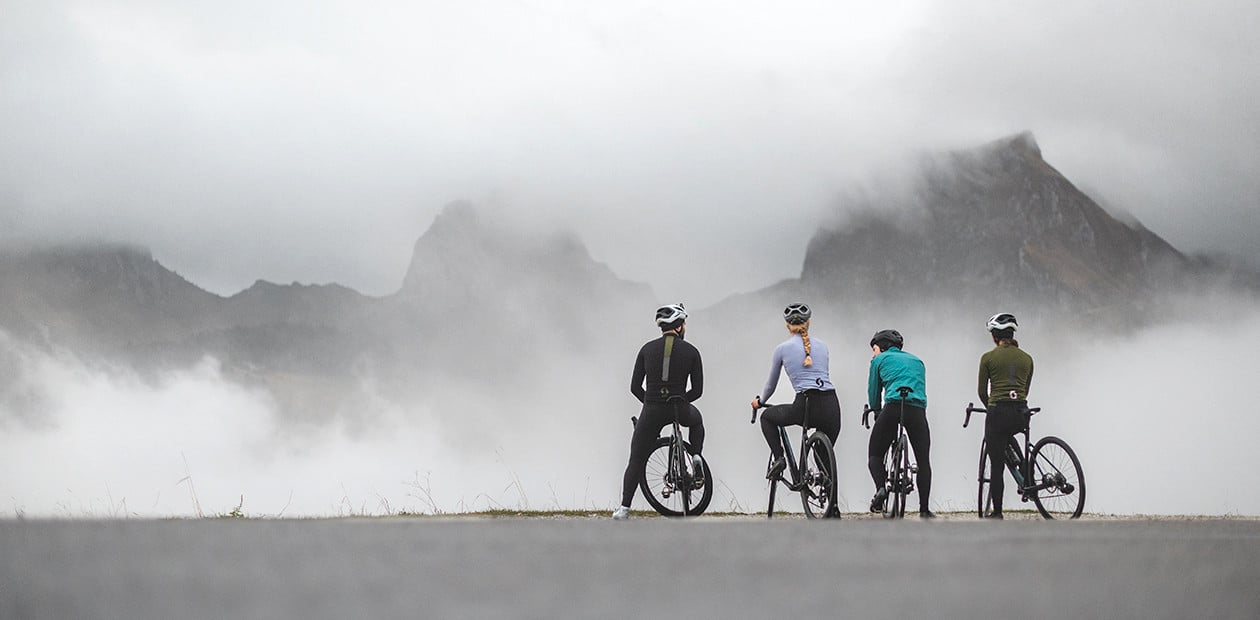Just because it's cold outside doesn't mean you have to put your bike into hibernation! With the right winter jacket, you can hop on your bike even in chilly weather and enjoy your cycling tours. In this post, you'll learn about the key features that make a good bike winter jacket and how to choose the right one for your needs.
5 Points to Consider for Winter Cycling Jackets
A high-quality bike winter jacket must meet some crucial requirements to keep cyclists warm and comfortable. Here are 5 key features to consider:

1. Materials and Layers in Winter Cycling Jackets
Modern winter cycling jackets are often made from a 3-layer softshell material, which includes a smooth water-repellent outer layer, a windproof membrane, and a warming fine fleece lining. These materials are elastic and breathable, ensuring freedom of movement and comfort on the bike.
As the temperature drops and the effort increases, it becomes crucial to opt for high-quality materials. Therefore, winter cycling jackets with inserts made of Winter Lycra are a good choice for cyclists engaged in intense activities. Winter Lycras are extremely elastic and breathable, effectively wicking away moisture while providing a snug fit.
Some jackets also feature insulation padding such as Primaloft, offering additional warmth. Using high-quality insulation materials like Primaloft or Primaloft Gold is crucial to produce an effective sports jacket. These materials not only provide excellent insulation against the cold but also wick away moisture. Jackets without such material may provide similar warmth but trap sweat due to exertion under the jacket, making them quickly uncomfortable.
2. Ergonomic Design and Specific Fit
The fit of a bike winter jacket is crucial and depends on your cycling discipline. Road cyclists often prefer a tight fit that accommodates the low riding position, while mountain bikers prefer a slightly looser jacket. A good winter jacket should be ergonomically adapted to the sitting position on the bike. This means the jacket is slightly shorter at the front to prevent bulging in a bent posture and slightly longer at the back to protect the lower back. Many jackets also have a stand-up collar, which also protects the neck from cooling.
The requirements for winter jackets vary depending on the type of cycling. For road cyclists, who ride in a low seating position, a tight, highly breathable jacket is essential. The fit of a road bike winter jacket minimizes air resistance, thus improving performance.
MTB winter jackets are slightly looser and more durable, as they also need to protect against dirt and splash water. In our blog posts, you can learn more about winter road bike training.

3. Elastic Cuffs for Non-Slip Fit
The cuffs of a bike winter jacket, whether on the sleeves or at the waist, play a crucial role in your comfort during long rides in cold weather.
Both cuffs are typically made of elastic material to prevent unwanted riding up or slipping during the ride. This ensures that cold air cannot penetrate the jacket, keeping you warm.
Elastic cuffs also allow for a smooth combination with bike winter gloves, ensuring they can slide easily over the sleeves. This is particularly important to keep your hands warm and protected.
4. Pockets and Reflective Design Elements
A good bike winter jacket usually has three back pockets where you can store additional clothing or accessories. Some jackets also offer additional zippered pockets for valuables on the chest or sides.
Reflective design elements are crucial for the visibility of the cyclist on overcast days or in darkness. They ensure that you are seen by other road users early on.
5. Temperature Ratings and Jacket Selection: Staying Warm on the Bike
Not every winter is the same, and the weather can change quickly. Therefore, there are winter cycling jackets in different categories:
Cycling jackets with 1 ice crystal are ideal for the transitional period and offer low cold protection.
Cycling jackets with 2 ice crystals are more breathable and suitable for single-digit temperatures.
Cycling jackets with 3 ice crystals are windproof and weatherproof, suitable for temperatures around freezing.
Cycling jackets with 3+ ice crystals offer maximum cold protection for extremely cold days.
This allows you to comfortably filter to find the perfect jacket for your plans.
So, Which Jacket is Best for Winter Cycling?

There isn't "one" jacket that is always the best. Instead, winter cycling jackets have different use cases. Choosing the right bike winter jacket is crucial to enjoy your cycling tours in the cold season. Pay attention to the fit, the requirements of your cycling discipline, and the temperature rating to find the best jacket for your needs. Make sure to consult the size charts to ensure the optimal fit. A practical option is also buying winter jackets in a set with matching winter pants to protect yourself comprehensively against the cold. With the right winter jacket, you are well-equipped for any weather and can cycle all year round. Happy riding!



